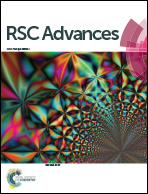A photochromic nano-system via self-recovery for stable photocatalytic hydrogen evolution by optimizing TiO2 surface energy†
Abstract
TiO2-based photocatalysts are promising candidates for photocatalytic hydrogen evolution that utilizes solar energy due to their low cost and high stability, but their activities are usually limited by the drawbacks of TiO2. Specifically, the fluctuation of surface energy, disturbed by light irradiation, can change the relative stability of the TiO2 exposed crystal faces, which has a great influence on the photocatalytic activity. Focusing on this problem, we built a bromine containing TiO2-based photochromic self-recovery system to immobilize bromine in the photocatalyst after photocatalysis. After a series of charge migration experiments, the photocatalysis of our photochromic system was clarified, and proved that TiO2 is the final electron accepter. This conclusion further emphasizes the importance of optimizing the TiO2 surface energy to promote TiO2-based photocatalysts. As a result, a sustained effect of reducing TiO2 surface energy can be achieved by repeating the bromine adsorption to harvest stable photocatalytic hydrogen evolution under ultraviolet and visible light irradiation.


 Please wait while we load your content...
Please wait while we load your content...